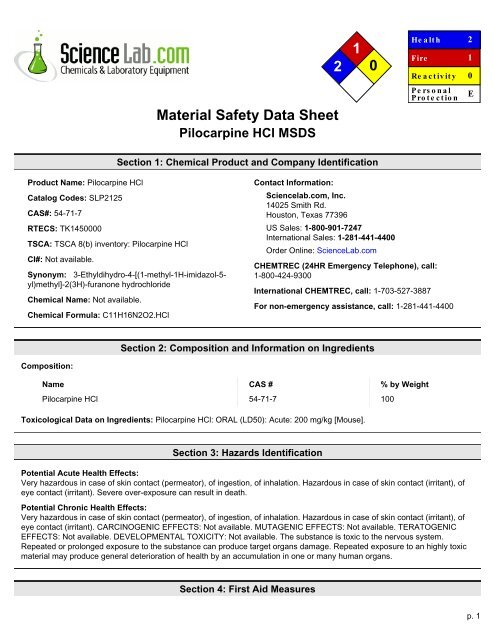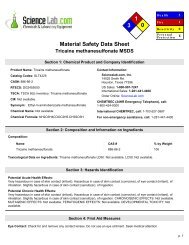MSDS for Pilocarpine HCl - ScienceLab
MSDS for Pilocarpine HCl - ScienceLab
MSDS for Pilocarpine HCl - ScienceLab
- No tags were found...
You also want an ePaper? Increase the reach of your titles
YUMPU automatically turns print PDFs into web optimized ePapers that Google loves.
Material Safety Data Sheet<br />
<strong>Pilocarpine</strong> <strong>HCl</strong> <strong>MSDS</strong><br />
1<br />
2 0<br />
He a lt h<br />
Fire<br />
Re a c t iv it y<br />
Pe rs o n a l<br />
Pro t e c t io n<br />
2<br />
1<br />
0<br />
E<br />
Section 1: Chemical Product and Company Identification<br />
Product Name: <strong>Pilocarpine</strong> <strong>HCl</strong><br />
Catalog Codes: SLP2125<br />
CAS#: 54-71-7<br />
RTECS: TK1450000<br />
TSCA: TSCA 8(b) inventory: <strong>Pilocarpine</strong> <strong>HCl</strong><br />
CI#: Not available.<br />
Synonym: 3-Ethyldihydro-4-[(1-methyl-1H-imidazol-5-<br />
yl)methyl]-2(3H)-furanone hydrochloride<br />
Chemical Name: Not available.<br />
Chemical Formula: C11H16N2O2.<strong>HCl</strong><br />
Contact In<strong>for</strong>mation:<br />
Sciencelab.com, Inc.<br />
14025 Smith Rd.<br />
Houston, Texas 77396<br />
US Sales: 1-800-901-7247<br />
International Sales: 1-281-441-4400<br />
Order Online: <strong>ScienceLab</strong>.com<br />
CHEMTREC (24HR Emergency Telephone), call:<br />
1-800-424-9300<br />
International CHEMTREC, call: 1-703-527-3887<br />
For non-emergency assistance, call: 1-281-441-4400<br />
Section 2: Composition and In<strong>for</strong>mation on Ingredients<br />
Composition:<br />
Name CAS # % by Weight<br />
<strong>Pilocarpine</strong> <strong>HCl</strong> 54-71-7 100<br />
Toxicological Data on Ingredients: <strong>Pilocarpine</strong> <strong>HCl</strong>: ORAL (LD50): Acute: 200 mg/kg [Mouse].<br />
Section 3: Hazards Identification<br />
Potential Acute Health Effects:<br />
Very hazardous in case of skin contact (permeator), of ingestion, of inhalation. Hazardous in case of skin contact (irritant), of<br />
eye contact (irritant). Severe over-exposure can result in death.<br />
Potential Chronic Health Effects:<br />
Very hazardous in case of skin contact (permeator), of ingestion, of inhalation. Hazardous in case of skin contact (irritant), of<br />
eye contact (irritant). CARCINOGENIC EFFECTS: Not available. MUTAGENIC EFFECTS: Not available. TERATOGENIC<br />
EFFECTS: Not available. DEVELOPMENTAL TOXICITY: Not available. The substance is toxic to the nervous system.<br />
Repeated or prolonged exposure to the substance can produce target organs damage. Repeated exposure to an highly toxic<br />
material may produce general deterioration of health by an accumulation in one or many human organs.<br />
Section 4: First Aid Measures<br />
p. 1
Eye Contact: Check <strong>for</strong> and remove any contact lenses. Do not use an eye ointment. Seek medical attention.<br />
Skin Contact:<br />
After contact with skin, wash immediately with plenty of water. Gently and thoroughly wash the contaminated skin with running<br />
water and non-abrasive soap. Be particularly careful to clean folds, crevices, creases and groin. Cover the irritated skin with an<br />
emollient. If irritation persists, seek medical attention. Wash contaminated clothing be<strong>for</strong>e reusing.<br />
Serious Skin Contact:<br />
Wash with a disinfectant soap and cover the contaminated skin with an anti-bacterial cream. Seek immediate medical<br />
attention.<br />
Inhalation: Allow the victim to rest in a well ventilated area. Seek immediate medical attention.<br />
Serious Inhalation:<br />
Evacuate the victim to a safe area as soon as possible. Loosen tight clothing such as a collar, tie, belt or waistband. If<br />
breathing is difficult, administer oxygen. If the victim is not breathing, per<strong>for</strong>m mouth-to-mouth resuscitation. Seek medical<br />
attention.<br />
Ingestion:<br />
Do not induce vomiting. Examine the lips and mouth to ascertain whether the tissues are damaged, a possible indication that<br />
the toxic material was ingested; the absence of such signs, however, is not conclusive. Loosen tight clothing such as a collar,<br />
tie, belt or waistband. If the victim is not breathing, per<strong>for</strong>m mouth-to-mouth resuscitation. Seek immediate medical attention.<br />
Serious Ingestion: Not available.<br />
Section 5: Fire and Explosion Data<br />
Flammability of the Product: May be combustible at high temperature.<br />
Auto-Ignition Temperature: Not available.<br />
Flash Points: Not available.<br />
Flammable Limits: Not available.<br />
Products of Combustion: These products are carbon oxides (CO, CO2), nitrogen oxides (NO, NO2...).<br />
Fire Hazards in Presence of Various Substances: Not available.<br />
Explosion Hazards in Presence of Various Substances:<br />
Risks of explosion of the product in presence of mechanical impact: Not available. Risks of explosion of the product in<br />
presence of static discharge: Not available.<br />
Fire Fighting Media and Instructions:<br />
SMALL FIRE: Use DRY chemical powder. LARGE FIRE: Use water spray, fog or foam. Do not use water jet.<br />
Special Remarks on Fire Hazards: Not available.<br />
Special Remarks on Explosion Hazards: Not available.<br />
Section 6: Accidental Release Measures<br />
Small Spill: Use appropriate tools to put the spilled solid in a convenient waste disposal container.<br />
Large Spill: Use a shovel to put the material into a convenient waste disposal container.<br />
Section 7: Handling and Storage<br />
Precautions:<br />
Keep locked up Keep away from heat. Keep away from sources of ignition. Empty containers pose a fire risk, evaporate the<br />
residue under a fume hood. Ground all equipment containing material. Do not ingest. Do not breathe dust. Wear suitable<br />
p. 2
Stability: The product is stable.<br />
Instability Temperature: Not available.<br />
Conditions of Instability: Not available.<br />
Incompatibility with various substances: Not available.<br />
Corrosivity: Non-corrosive in presence of glass.<br />
Special Remarks on Reactivity: Not available.<br />
Special Remarks on Corrosivity: Not available.<br />
Polymerization: No.<br />
Section 11: Toxicological In<strong>for</strong>mation<br />
Routes of Entry: Dermal contact. Eye contact. Inhalation. Ingestion.<br />
Toxicity to Animals: Acute oral toxicity (LD50): 200 mg/kg [Mouse].<br />
Chronic Effects on Humans: The substance is toxic to the nervous system.<br />
Other Toxic Effects on Humans:<br />
Very hazardous in case of skin contact (permeator), of ingestion, of inhalation. Hazardous in case of skin contact (irritant).<br />
Special Remarks on Toxicity to Animals: Not available.<br />
Special Remarks on Chronic Effects on Humans: Not available.<br />
Special Remarks on other Toxic Effects on Humans: Not available.<br />
Ecotoxicity: Not available.<br />
BOD5 and COD: Not available.<br />
Section 12: Ecological In<strong>for</strong>mation<br />
Products of Biodegradation:<br />
Possibly hazardous short term degradation products are not likely. However, long term degradation products may arise.<br />
Toxicity of the Products of Biodegradation: The products of degradation are as toxic as the original product.<br />
Special Remarks on the Products of Biodegradation: Not available.<br />
Waste Disposal:<br />
Section 13: Disposal Considerations<br />
Section 14: Transport In<strong>for</strong>mation<br />
DOT Classification:<br />
Identification:<br />
Special Provisions <strong>for</strong> Transport: Not available.<br />
Section 15: Other Regulatory In<strong>for</strong>mation<br />
p. 4





